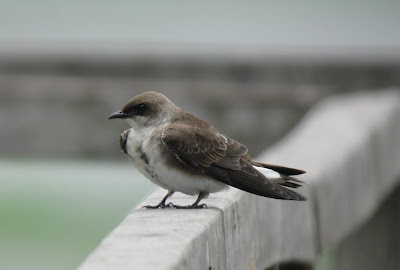Swallows and Martins of Brazil's Pantanal
While co-leading the 2010 Connecticut Audubon Society trip to Brazil's Pantanal, I tried to pay as much attention to members of the family Hirundinidae as time allowed. We enjoyed nice diversity, recording the following species:
~Blue-and-white Swallow - a few at the higher/drier locations outside the Pantanal
~Southern Rough-winged Swallow - scattered in various habitats throughout the trip
~Brown-chested Martin - abundant
~Gray-breasted Martin - very common
~Purple/Southern Martin - a single unidentified adult male seen briefly along the northern Transpantaneira; according to Giuliano, Purple certainly occurs in the Pantanal while the status of Southern Martin is uncertain (and perhaps never confirmed?). Males are extremely difficult to tell apart.
~White-winged Swallow - fairly common in the Pantanal
~Barn Swallow - a small group of three along the Transpantaneira
~Cliff Swallow - generally a scarce migrant here, but we encountered a massive flock of ~170 birds along the Transpantaneira on one day and a few scattered birds on other days
Here are some photos and notes on a few of these species, with a focus on those with vagrant potential to the U.S.
Brown-chested Martin (Progne tapera):
All individuals of this species seen well enough to ID to subspecies were of the Austral migrant race fusca, as expected here. This subspecies is characterized by a brown upper breast band with a series of dark dots forming a line down the center of the lower breast.
~Blue-and-white Swallow - a few at the higher/drier locations outside the Pantanal
~Southern Rough-winged Swallow - scattered in various habitats throughout the trip
~Brown-chested Martin - abundant
~Gray-breasted Martin - very common
~Purple/Southern Martin - a single unidentified adult male seen briefly along the northern Transpantaneira; according to Giuliano, Purple certainly occurs in the Pantanal while the status of Southern Martin is uncertain (and perhaps never confirmed?). Males are extremely difficult to tell apart.
~White-winged Swallow - fairly common in the Pantanal
~Barn Swallow - a small group of three along the Transpantaneira
~Cliff Swallow - generally a scarce migrant here, but we encountered a massive flock of ~170 birds along the Transpantaneira on one day and a few scattered birds on other days
Here are some photos and notes on a few of these species, with a focus on those with vagrant potential to the U.S.
Brown-chested Martin (Progne tapera):
All individuals of this species seen well enough to ID to subspecies were of the Austral migrant race fusca, as expected here. This subspecies is characterized by a brown upper breast band with a series of dark dots forming a line down the center of the lower breast.
Trip participant Morris Finkelstein was able to grab a few flight shots of this species with his SLR. Thanks to Morris for contributing these photos.
ID points:
- brown upperparts
- brown upper breast band that extends down the flanks laterally, and a series of dark dots forming a line down the center of the lower breast on P. t. fusca (Austral migrant that has been recorded in the U.S. on several occasions)
- the intensity of the brown breast band varies from rather diffuse to very dark
- the line of dots down center of breast often VERY difficult to see, especially in flight and on distant perched birds
- pale collar behind auriculars that is often quite noticeable at a distance and in flight
- white throat offset by a dusky, low-contrast lateral throat stripe
- white undertail coverts (or lateral rump/uppertail feathers?) sometimes flared laterally to show a thin white patch on the sides of the base of the tail
- moderately forked tail, equal to or just barely projecting beyond the folded wings at rest
- often glides on bowed wings
Gray-breasted Martin (Progne chalybea):















these flight shots are poor, but the general color pattern and tail shape are visible
- brown upperparts
- brown upper breast band that extends down the flanks laterally, and a series of dark dots forming a line down the center of the lower breast on P. t. fusca (Austral migrant that has been recorded in the U.S. on several occasions)
- the intensity of the brown breast band varies from rather diffuse to very dark
- the line of dots down center of breast often VERY difficult to see, especially in flight and on distant perched birds
- pale collar behind auriculars that is often quite noticeable at a distance and in flight
- white throat offset by a dusky, low-contrast lateral throat stripe
- white undertail coverts (or lateral rump/uppertail feathers?) sometimes flared laterally to show a thin white patch on the sides of the base of the tail
- moderately forked tail, equal to or just barely projecting beyond the folded wings at rest
- often glides on bowed wings
Gray-breasted Martin (Progne chalybea):















these flight shots are poor, but the general color pattern and tail shape are visible
ID points:
- steely blue/purple upperparts
- the darkness of the gray breast/throat varies, depending on the individual, lighting, and camera settings in photos
- gray breast fades into white/whitish belly and flanks
- lacks pale collar
- deeply forked tail
- tail projects beyond folded wings when perched
Comparison photo:

Two Brown-chested Martins at left, one Gray-breasted Martin at right.
Note the differences in structure noted above, in addition to plumage pattern.
- steely blue/purple upperparts
- the darkness of the gray breast/throat varies, depending on the individual, lighting, and camera settings in photos
- gray breast fades into white/whitish belly and flanks
- lacks pale collar
- deeply forked tail
- tail projects beyond folded wings when perched
Comparison photo:

Two Brown-chested Martins at left, one Gray-breasted Martin at right.
Note the differences in structure noted above, in addition to plumage pattern.
Southern Rough-winged Swallow (Stelgidopteryx ruficollis):
While I did not take much time to study or photograph this species, the two most obvious ways to separate this bird from our Northern Rough-winged Swallow are its frosty rump and cinnamon-tinged throat.
While I did not take much time to study or photograph this species, the two most obvious ways to separate this bird from our Northern Rough-winged Swallow are its frosty rump and cinnamon-tinged throat.























Great shots and very thorough descriptions, thanks a lot! Looking forward to more photos in 2011!
ReplyDeleteThe id points are very helpful!
ReplyDeleteI never got to see the two in direct comparison, but I did see hundreds of Southern Martins and I never once thought they could have been purples (I was pretty far south in Argentina at the time) they are incredibly black, and while iridescent, it is more like the iridecense of a grackle than a purple martin. just my 2 cents.
ReplyDelete